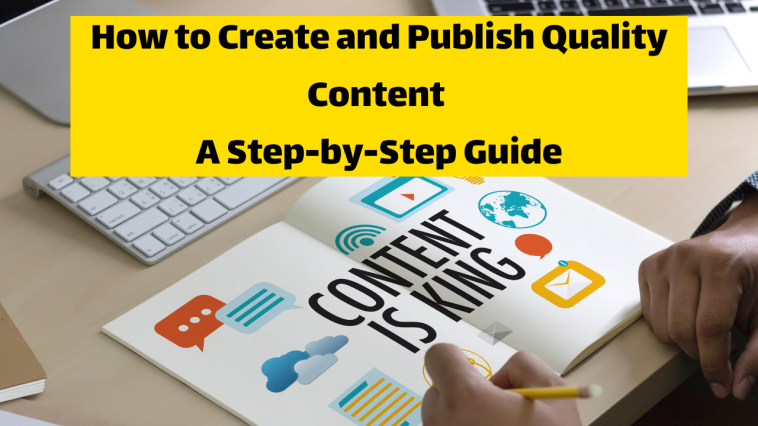You’ve come to the right spot if you’re an internet marketer or a business seeking solutions for crafting top-notch content that engages readers and boosts your search engine rankings. Becoming amazing at making quality content can improve your click-through rates (CTR) and assist you with drawing in visitors by utilizing keywords vital to your campaigns.
So, what’s the key to crafting high-quality content?
Contrary to a common myth, simply stuffing your content with keywords only sometimes makes it high-quality.
In reality, high-quality content aligns with your business’s message, ensuring readers understand your enterprise clearly. It should be free from plagiarism and grammatical errors—these are fundamental attributes of quality content. Creative content writers often build careers around these principles.
You may also like: Content is King: Why Should You Shouldn’t Underestimate Content Writing
Now, let’s delve into the steps required to create meaningful, informative, and engaging content.
1. Research Your Topic with Intent
Choosing topics you’re passionate about is the first step toward creating engaging and meaningful content. When genuinely interested in a subject, your enthusiasm will shine through in your writing or presentations.
List areas that genuinely excite you, inspire curiosity, or ignite your creativity. This could encompass various interests, such as hobbies, professional expertise, or personal experiences.
2. Embrace a Keyword-Centric Approach
When you have your list of topics, now is the ideal time to jump into keyword research. Keywords are the words and phrases individuals often use while searching for information online. Finding the right keywords is crucial because they can significantly impact your content’s discoverability.
Various tools, such as Google Keyword Planner, SEMrush, Google Trends, and Ahrefs, can help you identify popular keywords related to your chosen topics. Search for keywords with a reasonable amount of traffic and low levels of competition.
You may also like: Why Keyword Research and Planning is important for SEO?
3. Brainstorm Content Ideas
Once you’ve identified the right keywords, the next step involves selecting a relevant topic or niche for your articles. Ensuring content remains closely tied to the chosen topic is essential for producing high-quality material.
Online marketing experts advise conducting audience research to gauge market size and effectively reach your target audience. After brainstorming your content, perform basic keyword research to identify the top searches related to your chosen topic.
4. Craft a Thoughtful Title
A well-crafted title is essential for search engine optimization. When people search online, they enter specific topics, keywords, or phrases into the search bar. Failing to create an engaging title for your content can result in fewer clicks.
Ensure your titles and meta descriptions are unique to your content, allowing search engines to index them and boost your site’s rankings.
5. Prioritize Proper Content Formatting
Optimizing your content for search engines and enhancing its appearance on the first page requires high-quality information and effective formatting for readability. When your content is well-structured and easy to read, it improves user experience and boosts your SEO efforts. Here are some crucial formatting advice to think about:
- Utilize Subheadings
- Appropriate Indentation
- Use Bullet Points and Numbered Lists
- Paragraph Length
- Emphasize Important Points
- Incorporate Multimedia
- Mobile-Friendly Formatting
- Consistent Style
6. Choose an Appropriate Design
The layout and overall page design are crucial in presenting your content online. It provides readers with insights into the content’s nature. Consider using distinct background colors, bold fonts, and larger text when designing your page. These elements help visitors quickly grasp the essence of your page.
7. Properly Content Publication
Once you’ve brainstormed your content, it’s time to begin publication. This entails creating links to your content across various online platforms where it will be accessible. For example, readers can find your content through blog entries, news sites, and social media platforms on the off chance that you compose a blog post on your site.
There are multiple ways of dispersing your content on the web, so it’s vital to get these services to match your content targets and spending plan.
8. Content Optimization
The final step in creating and publishing quality online content is optimization. This crucial phase is all about ensuring that your content meets your target audience’s needs and expectations and ranks well in search engine results.
Effective content optimization involves implementing proper SEO (Search Engine Optimization) techniques to maximize visibility and reach. Key elements of content optimization include the following:
- Keyword Research
- Keyword Placement
- High-Quality Content
- Optimize Meta Data
- Header Tags
- Image Optimization
- Internal and External Links
- Regular Updates
- Mobile Optimization
- Monitor Performance
You may also like How to Write Engaging and SEO-Friendly Blog Posts. 7 Best Practices.
Conclusion:
In conclusion, successful content creation and optimization require combining essential elements. It starts with choosing topics that genuinely interest you and align with your expertise.
Creative content ideas that resonate with your target audience should follow. Crafting captivating titles is essential for both SEO and user engagement. Proper content formatting, design considerations, and widespread publication on various online platforms enhance visibility.
Finally, content optimization, including keyword placement, high-quality content creation, and ongoing monitoring, ensures that your content meets your audience’s needs and ranks well in search engine results, contributing to a lasting online presence.






